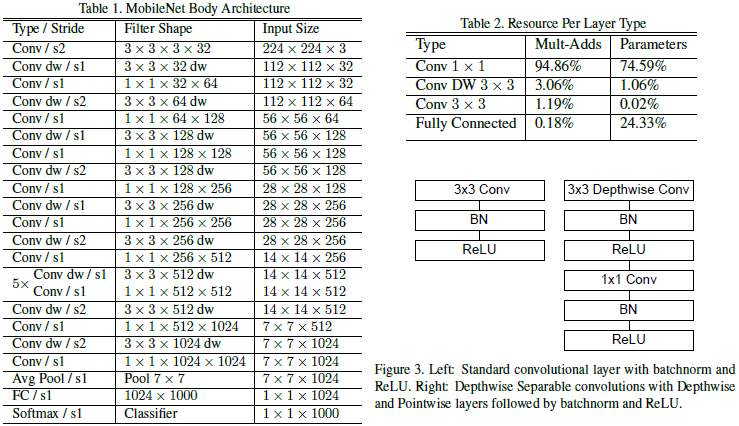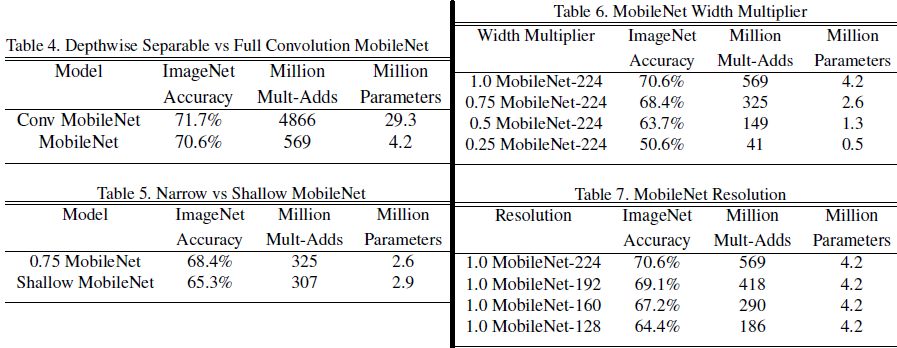论文: MobileNets: Efficient Convolutional Neural Networks for Mobile Vision Applications
github: https://github.com/pby5/MobileNet_Caffe
https://github.com/Zehaos/MobileNet
论文算法概述
MobileNets基于流线型结构,使用depthwise separable convolution(出自《Xception: Deep learning with depthwise separable convolutions》)构建而成的深度神经网络,并引入两个简单的全局超参数去平衡速度和精度。构建小的高效的模型是常被关注的问题,常见的处理方法可分为两类,压缩预训练模型或直接训练小模型,很多论文中主要关注模型大小,参数变少了,但前向时间却变长了。而MobileNets主要关注速度问题,同时兼顾模型大小。
优化结构,也考虑速度。
Depthwise Separable Convolution
MobileNet模型基于depthwise separable convolutions,这种卷积可以分解为一个depthwise convolution和1x1的pointwise convolution。depthwise convolution对每个输入通道采用单一滤波器,pointwise convolution则使用1x1卷积去线性融合depthwise convolution的输出,共两步操作。而标准的卷积中,滤波和信息融合都会在一步中完成。这样分解能够较大程度上减少网络计算量和模型大小。如图2中表示由标准卷积2(a)分解成一个depthwise convolution 2(b)和一个1x1 pointwise convolution 2(c).

一个标准的卷积层以Df x Df x M的特征图F输入,得到Df x Df x N的特征图G输出,Df表示特征图空间上的高度和宽度,M/N为通道数。设Dk为卷积核大小。则参数数量为Dk x Dk x M x N,计算量可以表示为Dk x Dk x M x Df x Df x N。MobileNets模型中,通过使用depthwise separable convolution来将输出通道数N和卷积核大小Dk隔离开。MobileNets中depthwise convolution采用的是单一的滤波器,计算量为Dk x Dk x M x Df x Df,pointwise convolution用于线性的信息融合,其计算量为1x 1x M x N x Df x Df,所以depthwise separable convolution的整体计算量为Dk x Dk x M x Df x Df + M x N x Df x Df。MobileNets中使用3x3的depthwise separable convolution可以减少8~9倍的运算量,而准确率下降不多。
Depthwise Separable Convolution
MobileNet除了第一层卷积为普通卷积外,其他卷积均由depthwise separable convolution堆叠而成,网络结构如table1所示,除了softmax分类层外,所有层都接着batchnorm和ReLU。其中最后一层卷积后添加一个均值池化将特征图大小变为1x1后输入全连接层。若depthwise separable convolution按两层算,则MobileNet有28个网络层。

Width Multiplier: Thinner Models
为使模型更轻量化,引入宽度因子alpha,作用在输入和输出的通道数上,则一层depthwise separable convolution的计算量为Dk x Dk x (alpha x M) x Df x Df + (alpha x M) x (alpha x N) x Df x Df,alpha的取值范围是0到1。
Resolution Multiplier: Reduced Representation
为使模型更轻量化,引入分辨率因子p,作用在输入大小Df上,则一层depthwise separable convolution的计算量为Dk x Dk x (alpha x M) x (p x Df) x (p x Df) + (alpha x M) x (alpha x N) x (p x Df) x (p x Df),p的取值范围是0到1。
Experiments


